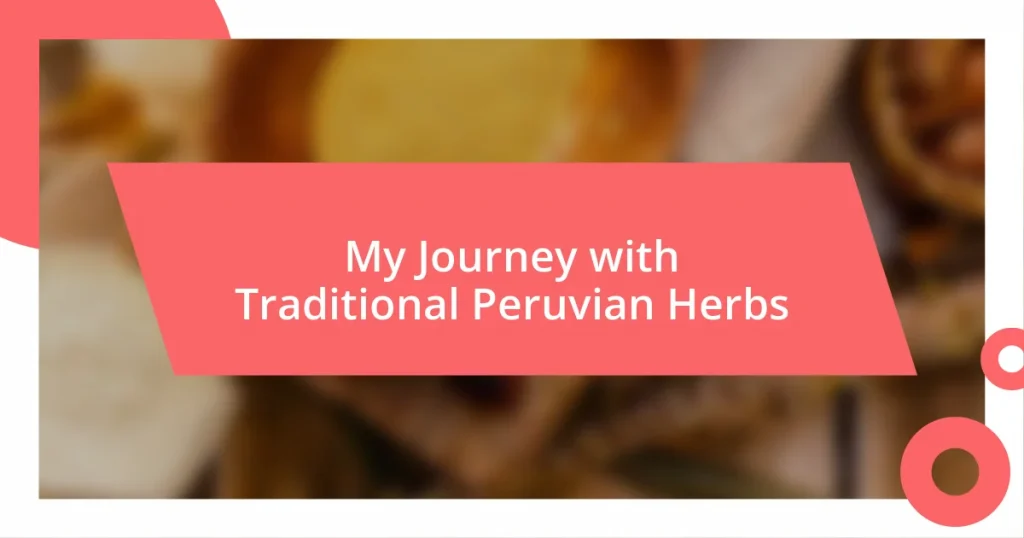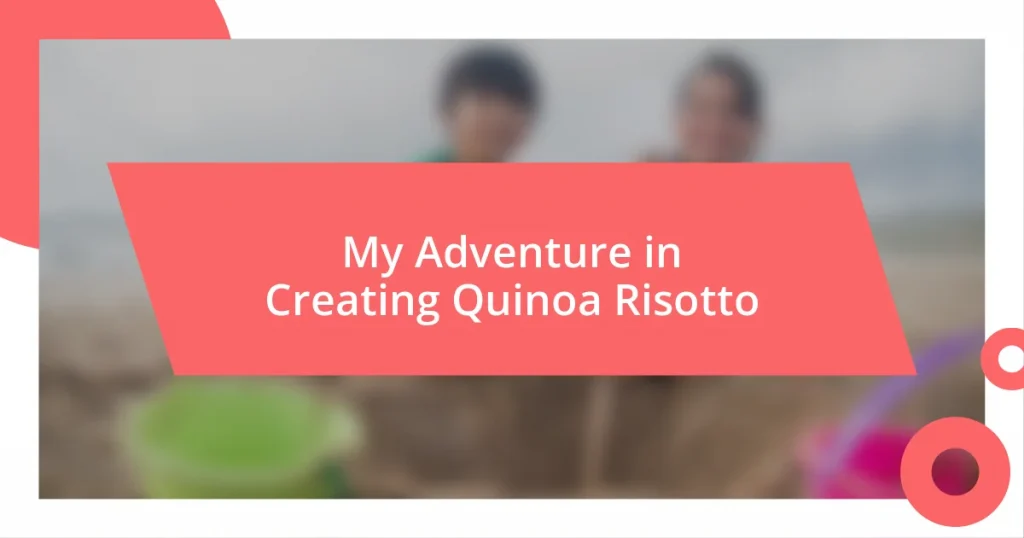Key takeaways:
- Peruvian herbs, like muña and coca, are deeply intertwined with cultural identity, history, and traditional healing practices, reflecting the wisdom of indigenous communities.
- Common traditional herbs such as Uña de Gato and Chanca Piedra showcase their medicinal benefits, emphasizing the holistic relationship between nature and well-being.
- Personal experiences with herbs, including culinary uses and wellness rituals, illustrate their profound impact on connecting individuals to cultural heritage and enhancing quality of life.
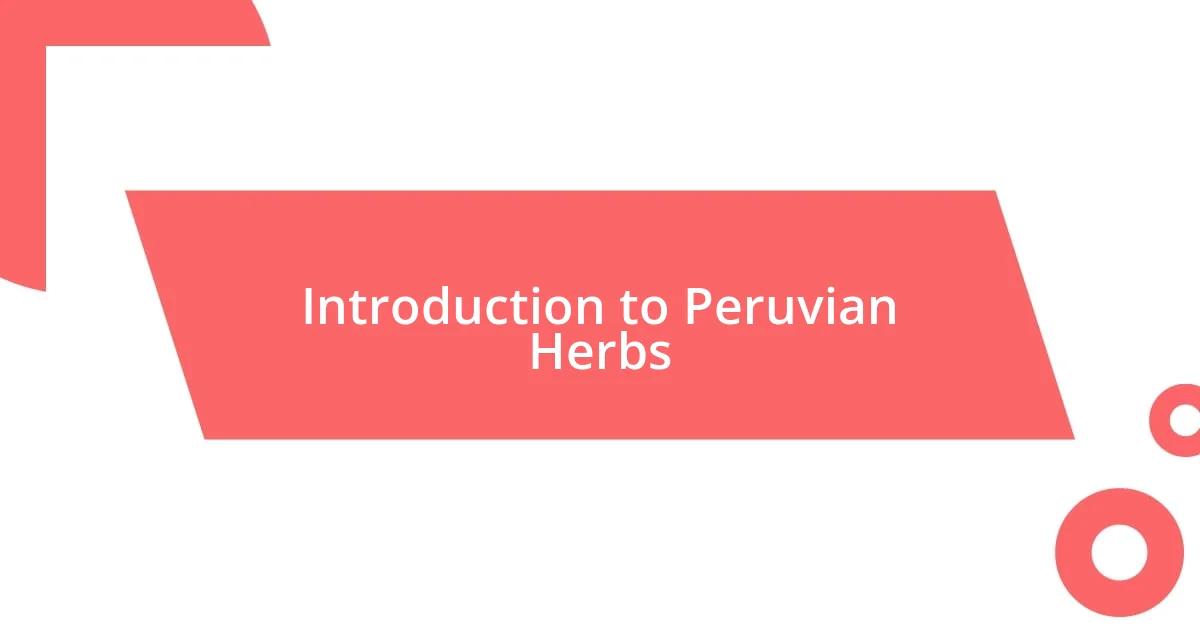
Introduction to Peruvian Herbs
Peruvian herbs carry an extraordinary cultural heritage, rooted in the diverse ecosystems of the Andes and Amazon, where indigenous communities have harnessed their medicinal and culinary properties for centuries. I recall the first time I encountered a small market in Cusco bustling with vibrant bundles of herbs; the aromas were intoxicating, arousing my curiosity about their unique benefits. What is it about these seemingly simple plants that has drawn people to them for generations?
Take, for instance, the famed muña (Minthostachys mollis). It wasn’t until a friend introduced me to its refreshing tea that I realized how deeply flavors can connect us to a place and its stories. This herb, often used to ease stomach ailments, also serves as a reminder that nature offers us remedies, if only we take the time to explore and appreciate them. Isn’t it fascinating how a sip of tea can take you on a journey through culture and tradition?
As I delved deeper into the uses of traditional Peruvian herbs, I discovered that each plant carries a tale of resilience and wisdom. The vibrant colors of the herbs reflect not just their health benefits but also the rich tapestry of life in Peru. Engaging with these plants has not only enriched my understanding of the local culture but also ignited a passion for discovering the myriad ways nature can nurture our well-being. Isn’t it amazing how something so small can have such a large impact on our lives?

Historical Significance of Peruvian Herbs
The use of herbs in Peru dates back thousands of years, interwoven with the cultural practices of ancient civilizations. I once stumbled upon a fascinating archaeological site that revealed remnants of herbs used in rituals, linking modern-day practices with the spiritual lives of the past. It’s incredible to think that the very plants I encountered in local markets played a role in ceremonies and healing methods so long ago, showcasing their enduring place in Peruvian heritage.
In my explorations, I learned that many Peruvian herbs symbolize strength and survival among indigenous communities. When I visited a remote village, the locals shared stories about their ancestors relying on herbs not just for nourishment but as essential tools for healing. Hearing their heartfelt narratives gave me an appreciation for the deep connection between these plants and their identity, cementing their place in the cultural fabric of Peru.
The historical significance of these herbs transcends mere culinary use. For instance, the use of coca leaves is a powerful example; they are not only integral to traditional practices but have also spurred countless discussions around agriculture, economy, and ethics. As I savored a bite of coca sweet, I was struck by its complex role in local culture—a reminder of how certain traditions can evoke multifaceted feelings and sparking conversations about social issues.
| Herb | Historical Significance |
|---|---|
| Muña | Used for digestive remedies by ancient civilizations, reflecting the holistic approach to health. |
| Coca | Symbolic of indigenous identity, revered in spiritual and cultural contexts throughout history. |
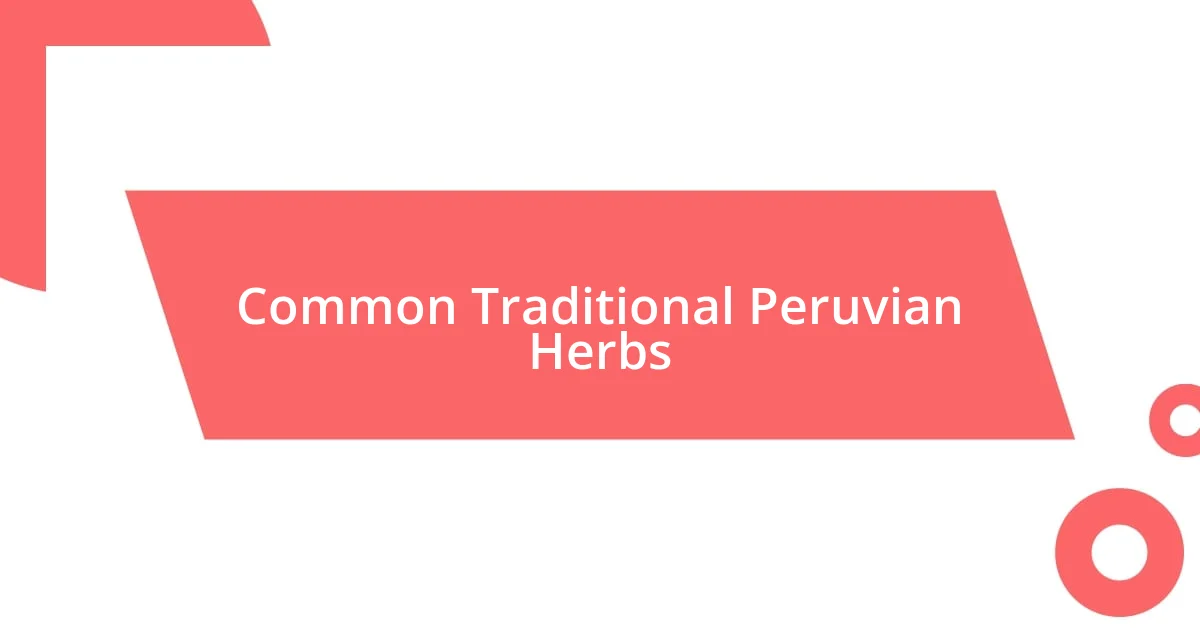
Common Traditional Peruvian Herbs
Exploring the world of traditional Peruvian herbs, I stumbled upon several gems that are integral to both the culture and health of the people. One afternoon, while wandering through the vibrant streets of Arequipa, I tried a fresh infusion of muña, which had a minty profile that felt remarkably revitalizing. Its soothing properties for upset stomachs had me thinking of how our bodies connect with such natural remedies—one sip, and I felt anchored in the heritage of this land.
Here’s a quick overview of some common traditional Peruvian herbs I found fascinating:
- Muña (Minthostachys mollis): Known for its digestive properties, this herb is a staple for calming stomach issues.
- Coca (Erythroxylum coca): Revered for its energy-boosting qualities, coca leaves also play a significant role in cultural rituals and traditional medicine.
- Uña de Gato (Cat’s Claw): This vine is honored for its immune-boosting capabilities and anti-inflammatory effects.
- Chanca Piedra (Phyllanthus niruri): Often celebrated as a kidney stone remedy, it highlights the traditional emphasis on natural healing.
- Palo Santo (Bursera graveolens): This aromatic wood is used in spiritual practices and rituals, carrying a sense of connection to the divine.
With each encounter I had with these herbs, there were stories intertwined with their unique traits that painted a vivid picture of life in Peru. One evening, as I prepared a dish that called for fresh cilantro, I was reminded of spirited celebrations where families gathered, sharing laughter and recipes. It’s incredible how these herbs have nurtured not just our bodies but also our spirits, fostering community and tradition. Their essence, imbued with love and culture, reminds me of the profound relationships we build with the world around us.
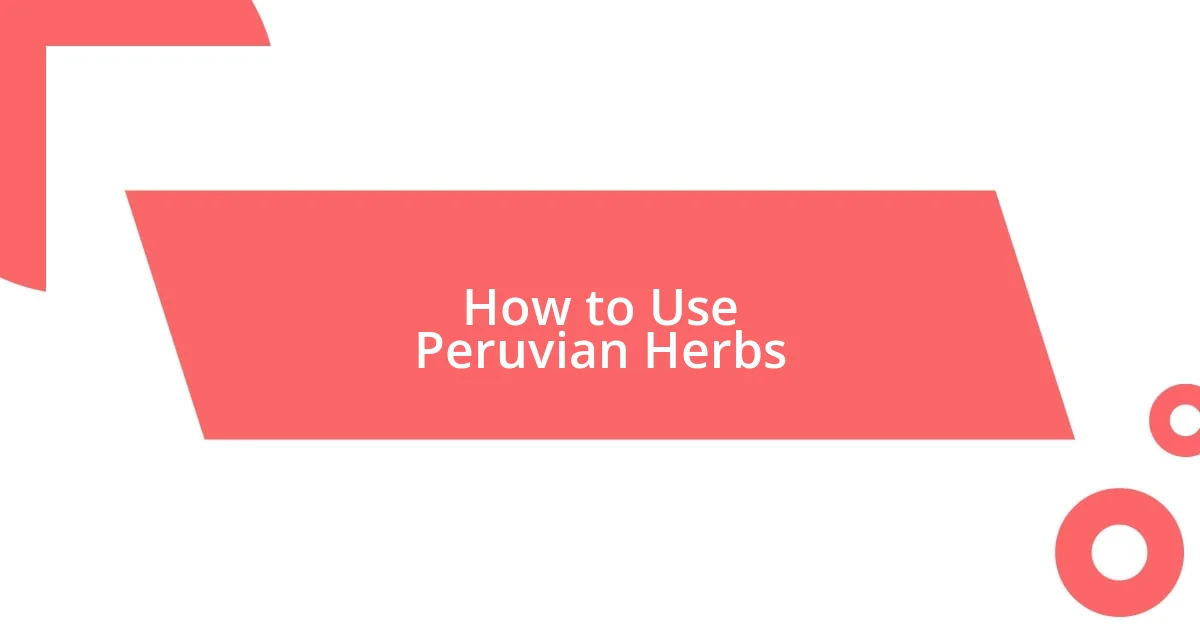
How to Use Peruvian Herbs
Using traditional Peruvian herbs opens up a world of flavors and benefits that can enrich our cooking and well-being. For me, incorporating muña into my herbal tea routine transformed my mornings. It’s not just a drink; it’s a fusion of invigorating energy and a nod to Peru’s rich heritage. Have you ever experienced a simple herb that instantly brightened your day? I certainly have!
When I wanted to experiment with coca leaves, I faced an internal debate. Should I treat this revered herb as just another ingredient? In the end, I decided to craft a refreshing beverage by steeping the leaves with a hint of lime and honey. The resulting drink was vibrant and uplifting, bridging ancient tradition and my modern palate. It left me wondering how something so simple could so deeply resonate across generations.
I’ve also found great joy in using Uña de Gato in my health regimen. After learning about its immune-boosting properties, I started adding it to my smoothies. The earthy taste reminds me of my travels along the Amazon, surrounded by flora that holds centuries of wisdom. Every sip becomes a journey through Peru’s natural landscape, grounding me while gifting me its ancient healing. How can we resist the allure of such an enriching experience that connects us to the earth?
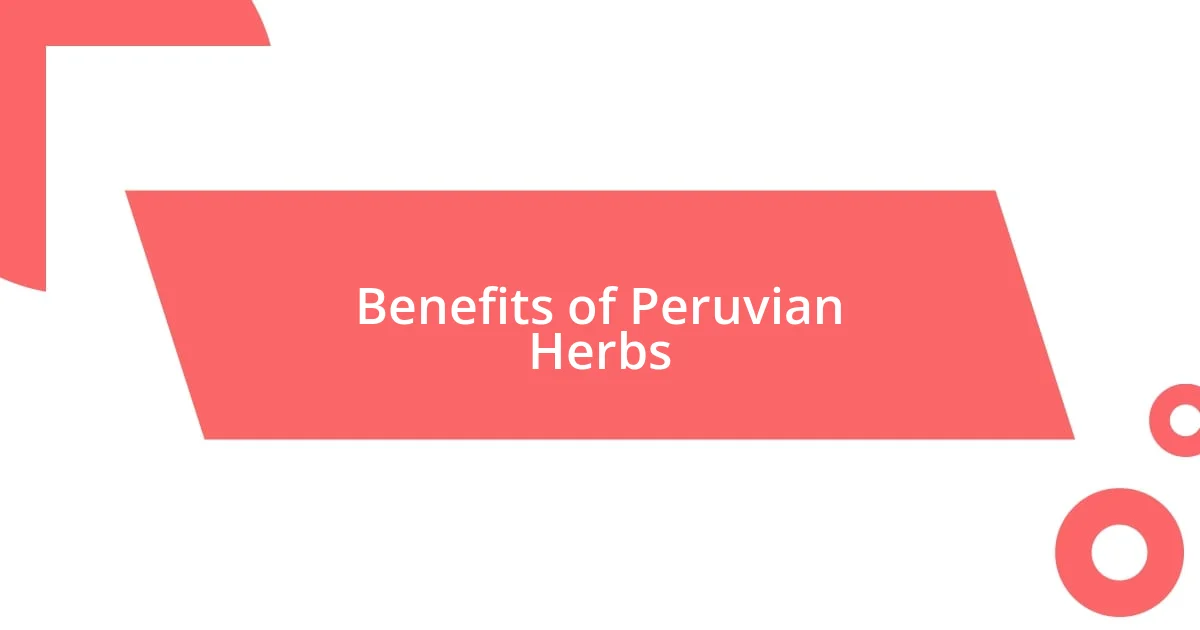
Benefits of Peruvian Herbs
The benefits of traditional Peruvian herbs are profound and often deeply personal to those who use them. Take Coca leaves, for instance. When I first chewed on a few while hiking in the Andes, I felt an immediate surge of energy that propelled me along the challenging trails. It wasn’t just about the physical boost; there was a sense of connection to the land and its people, who have revered this herb for centuries to combat fatigue and altitude sickness. How incredible is it that nature provides such powerful allies in our daily adventures?
Muña has also become a staple in my life, particularly as a soothing tea before bedtime. One evening after a long day, I brewed a cup infused with muña, and the calming aroma enveloped me like a warm embrace. It helped settle my mind and eased my digestion, reminding me of Peru’s rich heritage of natural remedies. I can’t help but wonder how many others have found solace in this humble herb, creating a shared experience across time and place.
Then there’s Uña de Gato, which I discovered while exploring herbal markets in Cusco. I vividly recall the moment a local vendor shared its secrets with me—how it supports the immune system and has anti-inflammatory properties. I started incorporating it into my daily smoothies, feeling a renewed sense of vitality. Every sip not only nourishes my body but also connects me to the wisdom of the Amazon rainforest. Isn’t it fascinating how these simple plants can encapsulate the essence of health and traditions, building a bridge between personal well-being and cultural history?
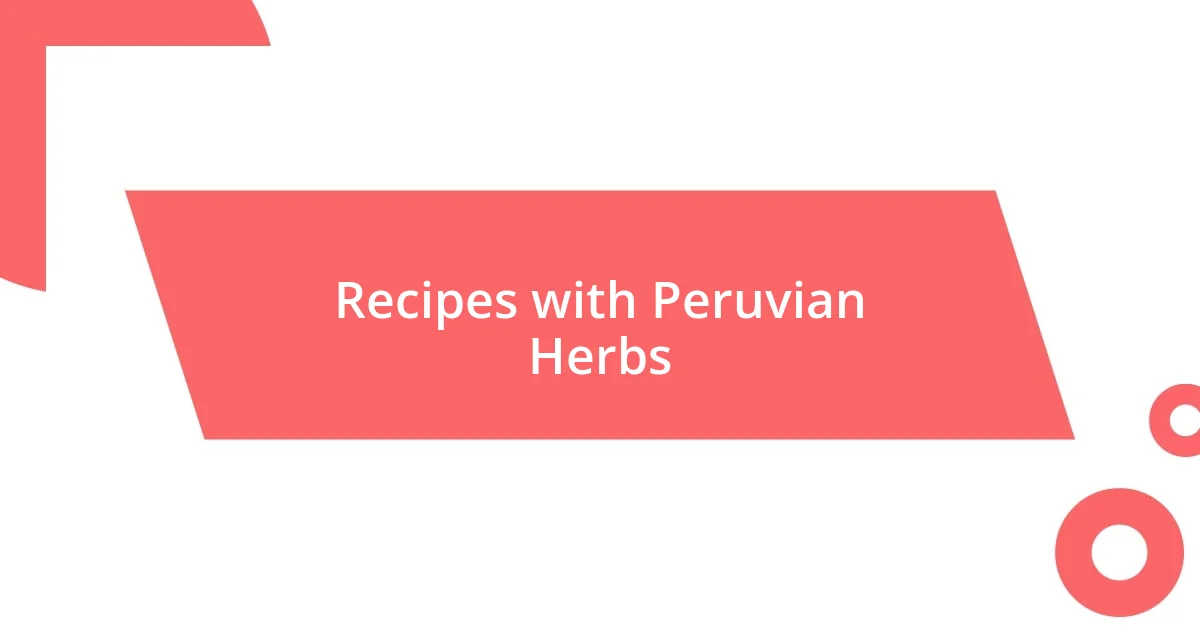
Recipes with Peruvian Herbs
When I stumbled upon a traditional Peruvian recipe for Aji de Gallina, I was more than excited to try it. This dish, usually made with succulent chicken, transforms when you add fresh herbs like cilantro and huacatay. The aroma that wafts through the kitchen while simmering is simply irresistible, and it instantly reminds me of family gatherings, where laughter and the rich scent of spices come together. Have you ever felt like a recipe holds not just flavors, but also memories?
Recently, I decided to experiment with a refreshing Peruvian salad featuring fresh mango, avocado, and a sprinkle of muña. The combination was not only visually stunning, but it also awakened my taste buds. I tossed in a bit of lime juice and a dash of chili for that perfect zing, creating a dish that dazzled my palate while evoking memories of sunlit afternoons spent sharing meals with friends. Each bite felt like a celebration of life and the bounty of the earth.
For a cozy evening, I made a simple herbal tea using dried coca leaves, inspired by my time in the Andes. As I steeped them, the rich fragrance took me back to those peaceful mountain moments. I added a slice of ginger and a spoonful of honey, elevating the experience into something heartwarming. This little ritual brings tranquility to my nights, reminding me of the power of silence and the natural strength these herbs embody. Isn’t it amazing how a cup of tea can evoke such deep feelings and transport us back to another place?

Personal Experiences and Insights
The first time I encountered huacatay, I was at a bustling street market in Lima. Its unique aroma captivated me immediately, but the real magic happened when I sprinkled it over grilled meats. The flavor was a revelation, igniting memories of summer BBQs back home with family. Can a simple herb really evoke such nostalgia? For me, it made me realize how food transcends boundaries and intertwines cultures through taste.
I’ll never forget the day I participated in a traditional ayahuasca ceremony deep in the Peruvian jungle. As the brew coursed through my veins, I felt an amalgamation of fear, healing, and enlightenment. It was akin to a spiritual awakening, guided by the wisdom of plants that have been used for generations. I often ponder, how can these ancient practices resonate so profoundly in our modern lives? Each moment felt like a connection to something greater than myself, a reminder of the earth’s enduring power.
One quiet afternoon, while experimenting with a blend of dried herbs for a personal wellness ritual, I found myself blending chamomile with a hint of muña and a drop of essential oils. The instant the soothing steam met my face, all my stress seemed to melt away. It struck me how, in that small act, I was honoring traditions passed down through generations while also crafting a moment just for me. Isn’t it fascinating how tradition can coexist with personal growth, layering our experiences like the rich flavors of our beloved herbs?










